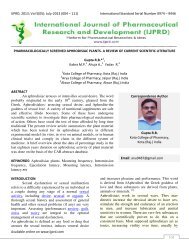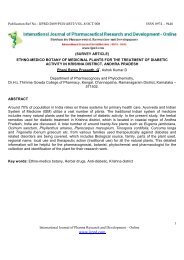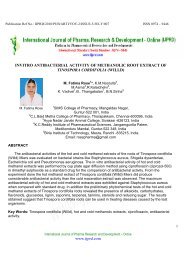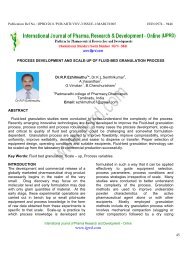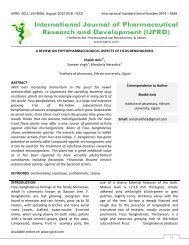in-vitro studies on the antiviral property of lantana camara ... - IJPRD
in-vitro studies on the antiviral property of lantana camara ... - IJPRD
in-vitro studies on the antiviral property of lantana camara ... - IJPRD
Create successful ePaper yourself
Turn your PDF publications into a flip-book with our unique Google optimized e-Paper software.
<strong>IJPRD</strong>, 2011; Vol 3(10): December 2011 (111 - 116) Internati<strong>on</strong>al Standard Serial Number 0974 – 9446<br />
----------------------------------------------------------------------------------------------------------------------------------------------------------------<br />
ABSTRACT<br />
Available <strong>on</strong>l<str<strong>on</strong>g>in</str<strong>on</strong>g>e <strong>on</strong> www.ijprd.com<br />
IN-VITRO STUDIES ON THE ANTIVIRAL PROPERTY OF LANTANA CAMARA FLOWERS<br />
R. Kanagavalli* 2 ,<br />
M. Senthil kumar 1 , M. Rupesh kumar 2 , K. Kavitha 2 SD.Jagadeesh s<str<strong>on</strong>g>in</str<strong>on</strong>g>gh 2<br />
1 JSS College <strong>of</strong> Pharmacy, Rockland, Ootacamund, Tamil Nadu, India.<br />
2 East po<str<strong>on</strong>g>in</str<strong>on</strong>g>t college <strong>of</strong> pharmacy, Bidarahalli, Bangalore, Karnataka, India.<br />
Lantana <strong>camara</strong> is a herb hav<str<strong>on</strong>g>in</str<strong>on</strong>g>g antimicrobial, antidiabetic, hepatotoxic<br />
properties and is used <str<strong>on</strong>g>in</str<strong>on</strong>g> traditi<strong>on</strong>al system <strong>of</strong> medic<str<strong>on</strong>g>in</str<strong>on</strong>g>e. Extract from<br />
Flowers was prepared and different c<strong>on</strong>centrati<strong>on</strong>s <strong>of</strong> this extract were<br />
exam<str<strong>on</strong>g>in</str<strong>on</strong>g>ed for <strong>the</strong>ir activities aga<str<strong>on</strong>g>in</str<strong>on</strong>g>st microbial agents and for <strong>the</strong>ir<br />
tolerance by specific cell culture. The cell culture was challenged with<br />
different doses <strong>of</strong> virus and <strong>the</strong> cultures were observed whe<strong>the</strong>r <strong>the</strong>y<br />
can withstand or resist <strong>the</strong> challenge dose when treated with extract or<br />
whe<strong>the</strong>r <strong>the</strong> cell culture is capable <strong>of</strong> resist<str<strong>on</strong>g>in</str<strong>on</strong>g>g <strong>the</strong> <str<strong>on</strong>g>in</str<strong>on</strong>g>vasi<strong>on</strong> or <str<strong>on</strong>g>in</str<strong>on</strong>g>hibit<str<strong>on</strong>g>in</str<strong>on</strong>g>g<br />
<strong>the</strong> multiplicati<strong>on</strong> <strong>of</strong> <strong>the</strong> virus. Thereby, prevent<str<strong>on</strong>g>in</str<strong>on</strong>g>g <strong>the</strong> virus <str<strong>on</strong>g>in</str<strong>on</strong>g>fecti<strong>on</strong><br />
<strong>the</strong> different diluti<strong>on</strong>s <strong>of</strong> extract did show a very low level <strong>of</strong> protecti<strong>on</strong><br />
when challenged with a low dose <strong>of</strong> virus. The extract failed to protect<br />
<strong>the</strong> cell cultures with a high dose <strong>of</strong> virus challenge (100TCID50). In this<br />
<str<strong>on</strong>g>in</str<strong>on</strong>g>vestigati<strong>on</strong>, <strong>the</strong> polio virus Type I, RNA virus was used as a challenge<br />
virus and <strong>the</strong> result <str<strong>on</strong>g>in</str<strong>on</strong>g>dicated that <strong>the</strong> plant extract <strong>of</strong> flowers <strong>of</strong>fered<br />
better protecti<strong>on</strong> when <strong>the</strong> cells were treated with 300 µg/ml <strong>of</strong> <strong>the</strong><br />
extract.<br />
Corresp<strong>on</strong>dence to Author<br />
R.Kanagavalli<br />
East Po<str<strong>on</strong>g>in</str<strong>on</strong>g>t College <strong>of</strong> pharmacy,<br />
Bidarahalli, Bangalore,<br />
Karnataka, India.<br />
Email<br />
kanagasen@reddiffmail.com<br />
Key Words<br />
Cytopathic effect <str<strong>on</strong>g>in</str<strong>on</strong>g>hibiti<strong>on</strong>,<br />
cytotoxicity, polio virus Type-I,<br />
virus yield reducti<strong>on</strong>, Anti<br />
microbial activity.<br />
111
Internati<strong>on</strong>al Journal <strong>of</strong> Pharmaceutical Research & Development ISSN: 0974 – 9446<br />
INTRODUCTION<br />
Plants have been used as folk remedies and<br />
ethnobotanical literature has described <strong>the</strong> usage <strong>of</strong><br />
plant extracts, <str<strong>on</strong>g>in</str<strong>on</strong>g>fusi<strong>on</strong>s and powders for centuries for<br />
diseases now known to be <strong>of</strong> viral orig<str<strong>on</strong>g>in</str<strong>on</strong>g>. [1] There is an<br />
<str<strong>on</strong>g>in</str<strong>on</strong>g>creas<str<strong>on</strong>g>in</str<strong>on</strong>g>g need for search <strong>of</strong> new compounds with<br />
<strong>antiviral</strong> activity as <strong>the</strong> treatment <strong>of</strong> viral <str<strong>on</strong>g>in</str<strong>on</strong>g>fecti<strong>on</strong>s with<br />
<strong>the</strong> available <strong>antiviral</strong> drugs is <strong>of</strong>ten unsatisfactory due<br />
to <strong>the</strong> problem <strong>of</strong> viral resistance [2] coupled with <strong>the</strong><br />
problem <strong>of</strong> viral latency and c<strong>on</strong>flict<str<strong>on</strong>g>in</str<strong>on</strong>g>g efficacy <str<strong>on</strong>g>in</str<strong>on</strong>g><br />
recurrent <str<strong>on</strong>g>in</str<strong>on</strong>g>fecti<strong>on</strong> <str<strong>on</strong>g>in</str<strong>on</strong>g> immunocompromised patients [3] .<br />
Ethnopharmacology provides an alternative approach<br />
for <strong>the</strong> discovery <strong>of</strong> <strong>antiviral</strong> agents, namely <strong>the</strong> study <strong>of</strong><br />
medic<str<strong>on</strong>g>in</str<strong>on</strong>g>al plants with a history <strong>of</strong> traditi<strong>on</strong>al use as a<br />
potential source <strong>of</strong> substances with significant<br />
pharmacological and biological activities [4] . The Indian<br />
subc<strong>on</strong>t<str<strong>on</strong>g>in</str<strong>on</strong>g>ent is endowed with rich and diverse local<br />
health traditi<strong>on</strong>, which is equally matched with rich and<br />
diverse plant genetic source [5] . The ancient system <strong>of</strong><br />
medic<str<strong>on</strong>g>in</str<strong>on</strong>g>e such as Ayurveda and used to treat various<br />
diseases and disorders. With<str<strong>on</strong>g>in</str<strong>on</strong>g> <strong>the</strong> past decade<br />
<strong>the</strong>rapeutic opti<strong>on</strong>s for viral <str<strong>on</strong>g>in</str<strong>on</strong>g>fecti<strong>on</strong>s have improved<br />
significantly, however, <strong>the</strong> emergence <strong>of</strong> resistant<br />
viruses as well. The fur<strong>the</strong>r disposal <strong>of</strong> resistant stra<str<strong>on</strong>g>in</str<strong>on</strong>g>s is<br />
<strong>on</strong>e reas<strong>on</strong> for <strong>the</strong>rapeutic failure [6-8] . Fur<strong>the</strong>rmore,<br />
many <strong>of</strong> <strong>the</strong> licensed drugs are toxic as well as be<str<strong>on</strong>g>in</str<strong>on</strong>g>g<br />
expensive [9] . A detailed <str<strong>on</strong>g>in</str<strong>on</strong>g>vestigati<strong>on</strong> and<br />
documentati<strong>on</strong> <strong>of</strong> plants used <str<strong>on</strong>g>in</str<strong>on</strong>g> local health traditi<strong>on</strong>s<br />
and ethnopharmacological evaluati<strong>on</strong> to verify <strong>the</strong>ir<br />
efficacy and safety can lead to <strong>the</strong> development <strong>of</strong><br />
<str<strong>on</strong>g>in</str<strong>on</strong>g>valuable herbal drugs or isolati<strong>on</strong> <strong>of</strong> compounds <strong>of</strong><br />
<strong>the</strong>rapeutic value.<br />
Examples <str<strong>on</strong>g>in</str<strong>on</strong>g>cluded tann<str<strong>on</strong>g>in</str<strong>on</strong>g>s [10] , flav<strong>on</strong>es [11] , alkaloids [12] ,<br />
that displayed <str<strong>on</strong>g>in</str<strong>on</strong>g> <str<strong>on</strong>g>vitro</str<strong>on</strong>g> activity aga<str<strong>on</strong>g>in</str<strong>on</strong>g>st numerous viruses.<br />
It has been suggested that selecti<strong>on</strong> <strong>of</strong> plant <strong>on</strong> <strong>the</strong><br />
basis <strong>of</strong> ethno medical c<strong>on</strong>siderati<strong>on</strong>s gives a higher hit<br />
rate than screen<str<strong>on</strong>g>in</str<strong>on</strong>g>g programmes <strong>of</strong> general syn<strong>the</strong>tic<br />
products [13] . Bacopa m<strong>on</strong>neri has been used <str<strong>on</strong>g>in</str<strong>on</strong>g><br />
c<strong>on</strong>diti<strong>on</strong>s like epilepsy, <str<strong>on</strong>g>in</str<strong>on</strong>g>sanity, nervous disorders [14] ,<br />
Hypercicum hookerianum <str<strong>on</strong>g>in</str<strong>on</strong>g> anxiety and <str<strong>on</strong>g>in</str<strong>on</strong>g>flammati<strong>on</strong>,<br />
Usnea complanta and Tagetes m<str<strong>on</strong>g>in</str<strong>on</strong>g>uta for bacterial<br />
<str<strong>on</strong>g>in</str<strong>on</strong>g>fecti<strong>on</strong>s [14-17] , Santol<str<strong>on</strong>g>in</str<strong>on</strong>g>a chamaecyparissus as a<br />
stimulant, vermifuge and a stomachic [18] . A number <strong>of</strong><br />
plant extracts reported <str<strong>on</strong>g>in</str<strong>on</strong>g> traditi<strong>on</strong>al medic<str<strong>on</strong>g>in</str<strong>on</strong>g>e to have<br />
Available <strong>on</strong>l<str<strong>on</strong>g>in</str<strong>on</strong>g>e <strong>on</strong> www.ijprd.com<br />
anti-<str<strong>on</strong>g>in</str<strong>on</strong>g>fective properties were studied <str<strong>on</strong>g>in</str<strong>on</strong>g> our laboratory<br />
[19-23] and were also screened for <strong>antiviral</strong> activity. Polio<br />
virus Type-I are ubiquitous agents which cause a variety<br />
<strong>of</strong> diseases rang<str<strong>on</strong>g>in</str<strong>on</strong>g>g <str<strong>on</strong>g>in</str<strong>on</strong>g> severity from mild to severe, and<br />
<str<strong>on</strong>g>in</str<strong>on</strong>g> certa<str<strong>on</strong>g>in</str<strong>on</strong>g> cases, <strong>the</strong>se may even become life<br />
threaten<str<strong>on</strong>g>in</str<strong>on</strong>g>g, especially <str<strong>on</strong>g>in</str<strong>on</strong>g> immunocompromised<br />
patients. After primary <str<strong>on</strong>g>in</str<strong>on</strong>g>fecti<strong>on</strong>, Polio virus Type-I<br />
persists <str<strong>on</strong>g>in</str<strong>on</strong>g> <strong>the</strong> host for <strong>the</strong> lifetime. Polio virus Type-I<br />
<str<strong>on</strong>g>in</str<strong>on</strong>g>fecti<strong>on</strong> is thus c<strong>on</strong>sidered lifel<strong>on</strong>g <str<strong>on</strong>g>in</str<strong>on</strong>g>fecti<strong>on</strong>.<br />
Nucleoside analogues such as acyclovir (ACV),<br />
penciclovir etc., are <strong>the</strong> <strong>on</strong>ly approved drugs for <strong>the</strong><br />
treatment <strong>of</strong> Polio virus Type-I <str<strong>on</strong>g>in</str<strong>on</strong>g>fecti<strong>on</strong>s. However, <strong>the</strong><br />
widespread use <strong>of</strong> nucleoside based drugs has led to <strong>the</strong><br />
emergence <strong>of</strong> resistance <str<strong>on</strong>g>in</str<strong>on</strong>g> Polio virus Type-I especially<br />
am<strong>on</strong>g immunocompromised patients. Polio cases have<br />
decreased by over 99% s<str<strong>on</strong>g>in</str<strong>on</strong>g>ce 1988, from an estimated<br />
350 000 cases <str<strong>on</strong>g>in</str<strong>on</strong>g> more than 125 endemic countries <strong>the</strong>n,<br />
to 1604 reported cases <str<strong>on</strong>g>in</str<strong>on</strong>g> 2009. In 2010, <strong>on</strong>ly parts <strong>of</strong><br />
four countries <str<strong>on</strong>g>in</str<strong>on</strong>g> <strong>the</strong> world rema<str<strong>on</strong>g>in</str<strong>on</strong>g> endemic for <strong>the</strong><br />
disease - <strong>the</strong> smallest geographic area <str<strong>on</strong>g>in</str<strong>on</strong>g> history. Based<br />
<strong>on</strong> Ayurvedic and Siddha traditi<strong>on</strong>al herbal medic<str<strong>on</strong>g>in</str<strong>on</strong>g>e,<br />
several <strong>antiviral</strong> <str<strong>on</strong>g>studies</str<strong>on</strong>g> were performed to detect active<br />
natural products <str<strong>on</strong>g>in</str<strong>on</strong>g> higher plants. In <strong>the</strong>se <str<strong>on</strong>g>studies</str<strong>on</strong>g><br />
different viruses were <str<strong>on</strong>g>in</str<strong>on</strong>g>cluded, e.g. herpes simplex<br />
virus (HSV), fel<str<strong>on</strong>g>in</str<strong>on</strong>g>e immunodeficiency virus, coxsackie<br />
virus, <str<strong>on</strong>g>in</str<strong>on</strong>g>fluenza virus Para <str<strong>on</strong>g>in</str<strong>on</strong>g>fluenza virus, respiratory<br />
syncytial virus, etc., [10–15] Hence, <strong>the</strong> current study deals<br />
with <strong>the</strong> <strong>antiviral</strong> activity <strong>of</strong> methanolic extract <strong>of</strong><br />
Lantana <strong>camara</strong> flower has been observed by us<str<strong>on</strong>g>in</str<strong>on</strong>g>g <str<strong>on</strong>g>in</str<strong>on</strong>g>-<br />
<str<strong>on</strong>g>vitro</str<strong>on</strong>g> virus Polio Type I was carried out.<br />
MATERIALS & METHODS<br />
Plant materials, reagents, cell l<str<strong>on</strong>g>in</str<strong>on</strong>g>e and virus: The plant<br />
material was collected from <str<strong>on</strong>g>in</str<strong>on</strong>g> and around Ootacamund,<br />
Tamil Nadu, India and was au<strong>the</strong>nticated by <strong>the</strong><br />
Botanical Survey <strong>of</strong> India, Government Arts College,<br />
Ootacamund where sample specimen was deposited.<br />
Extract <strong>of</strong> Lantana <strong>camara</strong> Flowers was prepared by<br />
us<str<strong>on</strong>g>in</str<strong>on</strong>g>g Soxhlet extracti<strong>on</strong> unit (Borosil, Mumbai) as per<br />
<strong>the</strong> standard procedure [24] . Dulbecco’s modified Eagle’s<br />
medium (DMEM, Tryps<str<strong>on</strong>g>in</str<strong>on</strong>g>, penicill<str<strong>on</strong>g>in</str<strong>on</strong>g>, streptomyc<str<strong>on</strong>g>in</str<strong>on</strong>g> and<br />
amphoteric<str<strong>on</strong>g>in</str<strong>on</strong>g> B were purchased from Hi-media Labs,<br />
Mumbai, India. 3-(4, 5-dimethylthiazol-2-yl)-2,5diphenyl<br />
tetrazolium bromide (MTT) and SRB dye were<br />
112
Internati<strong>on</strong>al Journal <strong>of</strong> Pharmaceutical Research & Development ISSN: 0974 – 9446<br />
purchased from Sigma, USA. New born calf serum<br />
(NBCS) was procured from PAA Labs, Austria. A-549 Cell<br />
l<str<strong>on</strong>g>in</str<strong>on</strong>g>e was obta<str<strong>on</strong>g>in</str<strong>on</strong>g>ed from Pasteur Institute <strong>of</strong> India,<br />
Co<strong>on</strong>oor. A-549 cell l<str<strong>on</strong>g>in</str<strong>on</strong>g>e was grown <str<strong>on</strong>g>in</str<strong>on</strong>g> DMEM and 10%<br />
heat <str<strong>on</strong>g>in</str<strong>on</strong>g>activated NBCS, 100 IU/ml penicill<str<strong>on</strong>g>in</str<strong>on</strong>g>. The cells<br />
were ma<str<strong>on</strong>g>in</str<strong>on</strong>g>ta<str<strong>on</strong>g>in</str<strong>on</strong>g>ed at 37ºC <str<strong>on</strong>g>in</str<strong>on</strong>g> a humidified atmosphere<br />
with 5% CO2 and were sub cultured twice a week. Polio<br />
virus type I was collected from <strong>the</strong> Christian Medical<br />
College and Hospital, Vellore. The virus was propagated<br />
<str<strong>on</strong>g>in</str<strong>on</strong>g> A-549 cell l<str<strong>on</strong>g>in</str<strong>on</strong>g>e and <strong>the</strong> <str<strong>on</strong>g>in</str<strong>on</strong>g>fective titre <strong>of</strong> <strong>the</strong> stock<br />
soluti<strong>on</strong> was 10 -6 TCID50/ml (50% tissue culture<br />
<str<strong>on</strong>g>in</str<strong>on</strong>g>fective dose).<br />
EXPERIMENTAL DESIGN<br />
Cytotoxicity assay<br />
Lantana <strong>camara</strong> Flowers extract was separately<br />
dissolved <str<strong>on</strong>g>in</str<strong>on</strong>g> 1ml <strong>of</strong> distilled dimethyl sulphoxide (DMSO)<br />
and volume was made up to 10 ml with ma<str<strong>on</strong>g>in</str<strong>on</strong>g>tenance<br />
medium to obta<str<strong>on</strong>g>in</str<strong>on</strong>g> a stock soluti<strong>on</strong> <strong>of</strong> 1mg/ml<br />
c<strong>on</strong>centrati<strong>on</strong>, sterilized by filtrati<strong>on</strong> and fur<strong>the</strong>r<br />
diluti<strong>on</strong>s were made from <strong>the</strong> stock. The cytotoxicity<br />
assays were carried out us<str<strong>on</strong>g>in</str<strong>on</strong>g>g 0.1ml <strong>of</strong> cell suspensi<strong>on</strong>,<br />
c<strong>on</strong>ta<str<strong>on</strong>g>in</str<strong>on</strong>g><str<strong>on</strong>g>in</str<strong>on</strong>g>g 10,000 cells seeded <str<strong>on</strong>g>in</str<strong>on</strong>g> each well <strong>of</strong> a 96-well<br />
microtitre plate (Tars<strong>on</strong>s India Pvt. Ltd., Kolkata). Fresh<br />
medium c<strong>on</strong>ta<str<strong>on</strong>g>in</str<strong>on</strong>g><str<strong>on</strong>g>in</str<strong>on</strong>g>g different c<strong>on</strong>centrati<strong>on</strong>s <strong>of</strong> <strong>the</strong> test<br />
sample was added after 24 hr <strong>of</strong> seed<str<strong>on</strong>g>in</str<strong>on</strong>g>g. C<strong>on</strong>trol cells<br />
were <str<strong>on</strong>g>in</str<strong>on</strong>g>cubated without test sample and with DMSO.<br />
The little percentage <strong>of</strong> DMSO present <str<strong>on</strong>g>in</str<strong>on</strong>g> <strong>the</strong> wells<br />
(maximal 0.2%) was found not to affect <strong>the</strong> experiment.<br />
The microtitre plates were <str<strong>on</strong>g>in</str<strong>on</strong>g>cubated at 37ºC <str<strong>on</strong>g>in</str<strong>on</strong>g> a<br />
humidified <str<strong>on</strong>g>in</str<strong>on</strong>g>cubator with 5% CO2 for a period <strong>of</strong> 72 hr.<br />
Available <strong>on</strong>l<str<strong>on</strong>g>in</str<strong>on</strong>g>e <strong>on</strong> www.ijprd.com<br />
Sixteen wells were used for each c<strong>on</strong>centrati<strong>on</strong> <strong>of</strong> <strong>the</strong><br />
test sample. The morphology <strong>of</strong> <strong>the</strong> cells was <str<strong>on</strong>g>in</str<strong>on</strong>g>spected<br />
daily and observed for microscopically detectable<br />
alterati<strong>on</strong>s, i.e., loss <strong>of</strong> m<strong>on</strong>olayer, granulati<strong>on</strong> and<br />
vacuolizati<strong>on</strong> <str<strong>on</strong>g>in</str<strong>on</strong>g> <strong>the</strong> cytoplasm. The cytopathogenic<br />
effect (CPE) was scored. The 50% cytotoxic<br />
c<strong>on</strong>centrati<strong>on</strong> (CTC50), was determ<str<strong>on</strong>g>in</str<strong>on</strong>g>ed by <strong>the</strong> standard<br />
MTT assay [25,26] , Trypan blue dye exclusi<strong>on</strong> method [27] ,<br />
cell metabolic functi<strong>on</strong> by prote<str<strong>on</strong>g>in</str<strong>on</strong>g> estimati<strong>on</strong> [28] .<br />
Antiviral assay<br />
Different n<strong>on</strong>toxic c<strong>on</strong>centrati<strong>on</strong>s <strong>of</strong> test drug, i.e.,<br />
lower than CTC50 were checked for <strong>antiviral</strong> <strong>property</strong> by<br />
cytopathic effect (CPE) <str<strong>on</strong>g>in</str<strong>on</strong>g>hibiti<strong>on</strong> assay [29] and virus yield<br />
reducti<strong>on</strong> assay [30] aga<str<strong>on</strong>g>in</str<strong>on</strong>g>st different virus challenge<br />
doses <strong>of</strong> 10 and 100 TCID50. In CPE <str<strong>on</strong>g>in</str<strong>on</strong>g>hibiti<strong>on</strong> assay,<br />
cells were seeded <str<strong>on</strong>g>in</str<strong>on</strong>g> a 96-well microtitre plate with<br />
10,000 cells per well, <str<strong>on</strong>g>in</str<strong>on</strong>g>cubated at 37ºC <str<strong>on</strong>g>in</str<strong>on</strong>g> a humidified<br />
<str<strong>on</strong>g>in</str<strong>on</strong>g>cubator with 5% CO2 for a period <strong>of</strong> 48 hr. The plates<br />
were washed with fresh DMEM and challenged with<br />
different virus challenge doses and <str<strong>on</strong>g>in</str<strong>on</strong>g>cubated at 37ºC<br />
for 90 m<str<strong>on</strong>g>in</str<strong>on</strong>g> for adsorpti<strong>on</strong> <strong>of</strong> <strong>the</strong> virus. The cultures were<br />
treated with different diluti<strong>on</strong>s <strong>of</strong> Lantana <strong>camara</strong><br />
Flowers extract <str<strong>on</strong>g>in</str<strong>on</strong>g> fresh ma<str<strong>on</strong>g>in</str<strong>on</strong>g>tenance medium and<br />
<str<strong>on</strong>g>in</str<strong>on</strong>g>cubated at 37ºC for five days. Every 24 hr <strong>the</strong><br />
observati<strong>on</strong> was made and cytopathic effects were<br />
recorded (Table-1). Polio virus Type-I activity was<br />
determ<str<strong>on</strong>g>in</str<strong>on</strong>g>ed by <strong>the</strong> <str<strong>on</strong>g>in</str<strong>on</strong>g>hibiti<strong>on</strong> <strong>of</strong> cytopathic effect<br />
compared with c<strong>on</strong>trol, i.e., <strong>the</strong> protecti<strong>on</strong> <strong>of</strong>fered by<br />
<strong>the</strong> test samples to <strong>the</strong> cells was scored. In virus yield<br />
assay, reducti<strong>on</strong> <str<strong>on</strong>g>in</str<strong>on</strong>g> <strong>the</strong> yield <strong>of</strong> virus when cells were<br />
treated with <strong>the</strong> plant extract was determ<str<strong>on</strong>g>in</str<strong>on</strong>g>ed.<br />
Table 1 Microscopic observati<strong>on</strong> <strong>of</strong> cytopathic effect <str<strong>on</strong>g>in</str<strong>on</strong>g>hibiti<strong>on</strong> assay<br />
Compound C<strong>on</strong>centrati<strong>on</strong><br />
Period <strong>of</strong> observati<strong>on</strong><br />
name<br />
(µg/ml)<br />
24 Hours 48 Hours 72 Hours<br />
100 100 100 100 TCID 100 100<br />
TCID50 TCID50 TCID50<br />
50 TCID50 TCID50<br />
Virus c<strong>on</strong>trol √ √ ? √ ++++ ++++<br />
Flower extract 300 √ √ ? √ ++++ ++<br />
200 √ √ + √ ++++ ++<br />
100 √ √ ? √ +++ ++<br />
50 √ √ ? √ ++++ ++<br />
√ = Normal appearance, ? = CPE present (Cytopathic Effect), + = 25% CPE, ++ = 50% CPE<br />
+++ = 75% CPE, ++++ = 100% CPE<br />
113
Internati<strong>on</strong>al Journal <strong>of</strong> Pharmaceutical Research & Development ISSN: 0974 – 9446<br />
RESULTS<br />
Anti microbial activity <strong>of</strong> <strong>the</strong> methanol extract <strong>of</strong> <strong>the</strong><br />
Lantana <strong>camara</strong> Flower was studied aga<str<strong>on</strong>g>in</str<strong>on</strong>g>st Bacillus<br />
subtillis (Gr +ve), Salm<strong>on</strong>ella typhi (Gr-ve) and candida<br />
albicans showed moderate anti bacterial activity at a<br />
m<str<strong>on</strong>g>in</str<strong>on</strong>g>imum Inhibitory C<strong>on</strong>centrati<strong>on</strong> (MIC) <strong>of</strong> 31.25μg/ml<br />
aga<str<strong>on</strong>g>in</str<strong>on</strong>g>st Bacillus subtillis, maximum activity at MIC <strong>of</strong> 125<br />
μg/ml aga<str<strong>on</strong>g>in</str<strong>on</strong>g>st Salm<strong>on</strong>ella typhi and did not show<br />
antifungal activity even at a c<strong>on</strong>centrati<strong>on</strong> <strong>of</strong> 1000μg/ml<br />
% Growth <str<strong>on</strong>g>in</str<strong>on</strong>g>hibiti<strong>on</strong><br />
80<br />
70<br />
60<br />
50<br />
40<br />
30<br />
20<br />
10<br />
Available <strong>on</strong>l<str<strong>on</strong>g>in</str<strong>on</strong>g>e <strong>on</strong> www.ijprd.com<br />
0<br />
aga<str<strong>on</strong>g>in</str<strong>on</strong>g>st candida albicans. The methanol extract <strong>of</strong> <strong>the</strong><br />
Lantana <strong>camara</strong> flower, exhibited detectable <strong>antiviral</strong><br />
effect towards polio virus Type-I with an <str<strong>on</strong>g>in</str<strong>on</strong>g>hibitory<br />
c<strong>on</strong>centrati<strong>on</strong> for 50 per cent (IC50) <strong>of</strong> 200-300μg/ml<br />
respectively(Fig 1& 2). The results obta<str<strong>on</strong>g>in</str<strong>on</strong>g>ed by both CPE<br />
<str<strong>on</strong>g>in</str<strong>on</strong>g>hibiti<strong>on</strong> assay and virus yield assay were comparable<br />
(Fig 3). The virus yield reducti<strong>on</strong> was found to be less<br />
than 1.0 log (Table 2).<br />
100 150 200 250 300 400 500<br />
C<strong>on</strong>centrati<strong>on</strong> (µg/ml)<br />
Fig 1 Determ<str<strong>on</strong>g>in</str<strong>on</strong>g>ati<strong>on</strong> <strong>of</strong> total cellular prote<str<strong>on</strong>g>in</str<strong>on</strong>g> by SRB assay <str<strong>on</strong>g>in</str<strong>on</strong>g> A-549 cell l<str<strong>on</strong>g>in</str<strong>on</strong>g>e<br />
Fig 2 Determ<str<strong>on</strong>g>in</str<strong>on</strong>g>ati<strong>on</strong> <strong>of</strong> mitoch<strong>on</strong>drial syn<strong>the</strong>sis by MTT assay <str<strong>on</strong>g>in</str<strong>on</strong>g> A-549 cell l<str<strong>on</strong>g>in</str<strong>on</strong>g>e<br />
Fig 3 Photomicrographs <strong>of</strong> (A) Normal A-549 (small cell lung carc<str<strong>on</strong>g>in</str<strong>on</strong>g>oma) cell culture<br />
(B) Cytopathic effect <strong>of</strong> polio virus Type-I <strong>on</strong> a-548 cell culture<br />
114
Internati<strong>on</strong>al Journal <strong>of</strong> Pharmaceutical Research & Development ISSN: 0974 – 9446<br />
Table 2 Anti viral screen<str<strong>on</strong>g>in</str<strong>on</strong>g>g <strong>of</strong> Lantana Camara flower extract<br />
C<strong>on</strong>centrati<strong>on</strong><br />
(µg/ml)<br />
CPE (% protecti<strong>on</strong>) Virus yield assay<br />
100 TCID50 10 TCID50 100 TCID50 10 TCID50<br />
Available <strong>on</strong>l<str<strong>on</strong>g>in</str<strong>on</strong>g>e <strong>on</strong> www.ijprd.com<br />
300 31.5 88.0 < 1 log 1 log<br />
200 30.6 76.4 < 1 log < 1 log<br />
100 26.7 40.0 < 1 log < 1 log<br />
DISCUSSION<br />
In this <str<strong>on</strong>g>in</str<strong>on</strong>g>vestigati<strong>on</strong> <strong>the</strong> polio virus Type-I, a RNA virus is<br />
used as a challenge virus and <strong>the</strong> result <str<strong>on</strong>g>in</str<strong>on</strong>g>dicate that <strong>the</strong><br />
plant extract <strong>of</strong> flowers <strong>of</strong>fers better protecti<strong>on</strong> when<br />
<strong>the</strong> cells were treated with 300μg/ml <strong>of</strong> <strong>the</strong> extract. It<br />
may be possible that when used at a higher<br />
c<strong>on</strong>centrati<strong>on</strong>, which is not deleterious or toxic to <strong>the</strong><br />
cell culture, <strong>the</strong> extract may <strong>of</strong>fer better protecti<strong>on</strong><br />
which is to be worked out. S<str<strong>on</strong>g>in</str<strong>on</strong>g>ce it <str<strong>on</strong>g>in</str<strong>on</strong>g>hibits virus<br />
multiplicati<strong>on</strong> to a certa<str<strong>on</strong>g>in</str<strong>on</strong>g> extent, it may be worth while<br />
to <str<strong>on</strong>g>in</str<strong>on</strong>g>vestigate <strong>the</strong> extent it is capable <strong>of</strong> <str<strong>on</strong>g>in</str<strong>on</strong>g>hibit<str<strong>on</strong>g>in</str<strong>on</strong>g>g virus<br />
multiplicati<strong>on</strong> <str<strong>on</strong>g>in</str<strong>on</strong>g> cell culture.<br />
CONCLUSION<br />
In c<strong>on</strong>clusi<strong>on</strong>, <strong>the</strong> result <strong>of</strong> this study dem<strong>on</strong>strated that<br />
methanol extract <strong>of</strong> <strong>lantana</strong> <strong>camara</strong> flower shows<br />
better <strong>antiviral</strong> activity aga<str<strong>on</strong>g>in</str<strong>on</strong>g>st polio virus Type-I. Hence<br />
<strong>the</strong> present study justified <strong>the</strong> traditi<strong>on</strong>al use <strong>of</strong> <strong>lantana</strong><br />
<strong>camara</strong> wild <str<strong>on</strong>g>in</str<strong>on</strong>g> <strong>the</strong> treatment <strong>of</strong> viral diseases.<br />
ACKNOWLEDGEMENT<br />
The author is thankful to J.S.S College <strong>of</strong> pharmacy,<br />
Ooty, Tamilnadu, India for provid<str<strong>on</strong>g>in</str<strong>on</strong>g>g necessary facilities<br />
throughout this work.<br />
REFERENCES<br />
1) Vanden Berghe DA, Vliet<str<strong>on</strong>g>in</str<strong>on</strong>g>ck AJ, Vanho<strong>of</strong> L. Plant<br />
products as potential <strong>antiviral</strong> agents. Bull Inst Pasteur<br />
1986; 84: 101-147.<br />
2) De Clercq E. Antiviral agents: characteristic activity<br />
spectrum depend<str<strong>on</strong>g>in</str<strong>on</strong>g>g <strong>on</strong> <strong>the</strong> molecular target with which<br />
<strong>the</strong>y <str<strong>on</strong>g>in</str<strong>on</strong>g>teract. Adv Virus Res 1993; 42: 1-55.<br />
50 25.4 35.9 < 1 log < 1 log<br />
3) Field AK, Bir<strong>on</strong> KK. The end <strong>of</strong> <str<strong>on</strong>g>in</str<strong>on</strong>g>nocerice revisited:<br />
resistance <strong>of</strong> herpesvirus to <strong>antiviral</strong> drugs. Cl<str<strong>on</strong>g>in</str<strong>on</strong>g><br />
Microbiol Rev 1994; 7: 1-13.<br />
4) Vliet<str<strong>on</strong>g>in</str<strong>on</strong>g>ck AJ, Vanden Berghe DA. Can<br />
ethnopharmacology c<strong>on</strong>tribute to <strong>the</strong> development <strong>of</strong><br />
<strong>antiviral</strong> drugs. Ethnopharmacol 1991; 32: 141-153.<br />
5) Pushpangadan P. Role <strong>of</strong> traditi<strong>on</strong>al medic<str<strong>on</strong>g>in</str<strong>on</strong>g>e <str<strong>on</strong>g>in</str<strong>on</strong>g><br />
primary health care. In: Iyengar PK, Damodaran VK,<br />
Pushpangandan P, editors. Science for health.<br />
Trivandrum: State Committee <strong>on</strong> Science, Technology<br />
and Envir<strong>on</strong>ment, Government <strong>of</strong> Kerala; 1995.<br />
6) Gadreau A, Hill E, Balfour Jr., HH, et al. Phenotypic<br />
and genotypic characterizati<strong>on</strong> <strong>of</strong> acyclovir-resistant<br />
herpes simplex virus from immunocompromised<br />
patients. Journal <strong>of</strong> <str<strong>on</strong>g>in</str<strong>on</strong>g>fectious Disease. 1998; 178: 299 –<br />
303.<br />
7) Emery VC. Cytomegalovirus drug resistance. Antiviral<br />
Therapy. 1998; 4: 239 – 242.<br />
8) Safr<str<strong>on</strong>g>in</str<strong>on</strong>g> S, Cherr<str<strong>on</strong>g>in</str<strong>on</strong>g>gt<strong>on</strong> J, Jaffe HS. Cid<strong>of</strong>ovir: review <strong>of</strong><br />
current and potential cl<str<strong>on</strong>g>in</str<strong>on</strong>g>ical uses. Advance<br />
Experimental Medical Biology. 1999; 458: 111–120.<br />
9) Pillay D, Emery VC, Mutimer D, et al. Guidel<str<strong>on</strong>g>in</str<strong>on</strong>g>es for<br />
laboratory m<strong>on</strong>itor<str<strong>on</strong>g>in</str<strong>on</strong>g>g <strong>of</strong> treatment <strong>of</strong> persistent virus<br />
<str<strong>on</strong>g>in</str<strong>on</strong>g>fecti<strong>on</strong>s. Journal <strong>of</strong> Cl<str<strong>on</strong>g>in</str<strong>on</strong>g>ical Virology. 2000: 25: 73 –<br />
92.<br />
10) Fukuchi K, Sakagarmi H, Okuda T, Hatano T, Tanuma<br />
S, Kitajima K. Inhibiti<strong>on</strong> <strong>of</strong> herpes simplex virus <str<strong>on</strong>g>in</str<strong>on</strong>g>fecti<strong>on</strong><br />
by tannis and related compounds. Antiviral Res 1989;<br />
11: 285-297.<br />
11) De Rodriguez DJ, Chula J, Sim<strong>on</strong>s C, Armoros M,<br />
Veriohe AM, Girre L. Search for <str<strong>on</strong>g>in</str<strong>on</strong>g><str<strong>on</strong>g>vitro</str<strong>on</strong>g> <strong>antiviral</strong> activity<br />
<strong>of</strong> a new is<strong>of</strong>lav<strong>on</strong>e glycoside from Vlex europeus.<br />
Planta Med 1990; 50: 59-62.<br />
115
Internati<strong>on</strong>al Journal <strong>of</strong> Pharmaceutical Research & Development ISSN: 0974 – 9446<br />
12) Spedd<str<strong>on</strong>g>in</str<strong>on</strong>g>g G, Ratty A, Middlet<strong>on</strong> E Jr. Inhibiti<strong>on</strong> <strong>of</strong><br />
reverse transcriptases by flav<strong>on</strong>oids. Antiviral Res 1989;<br />
12: 99- 110.<br />
13) Vanden Berghe DA, Vliet<str<strong>on</strong>g>in</str<strong>on</strong>g>ek AJ. Screen<str<strong>on</strong>g>in</str<strong>on</strong>g>g methods<br />
for antibacterial and <strong>antiviral</strong> agents from higher plants.<br />
In: Hostettmann K, editor. Methods <str<strong>on</strong>g>in</str<strong>on</strong>g> biochemistry. vol<br />
6. L<strong>on</strong>d<strong>on</strong>: Academic Press; 1991 p. 47.<br />
14) The wealth <strong>of</strong> India, New Delhi: Council <strong>of</strong> Scientific<br />
and Industrial Research; 1995.<br />
15) Ambasta SP, editor, The useful plants <strong>of</strong> India. New<br />
Delhi: Council <strong>of</strong> Scientific and Industrial Research; 1986<br />
p. 617.<br />
16) Hobbs C. Usnea: The herbal antibiotic. Capitola (CA):<br />
Botanic Press; 1986 p. 913.<br />
17) Yoganarasimhan SN. Medic<str<strong>on</strong>g>in</str<strong>on</strong>g>al plants <strong>of</strong> India, Tamil<br />
Nadu. vol 2, Bangalore: Cyber Media; 2000.<br />
18) Vijayan P, V<str<strong>on</strong>g>in</str<strong>on</strong>g>od Kumar S, Dhanaraj SA, Badami S,<br />
Suresh B. In <str<strong>on</strong>g>vitro</str<strong>on</strong>g> cytotoxicity and antitumor properties<br />
<strong>of</strong> <strong>the</strong> total alkaloid fracti<strong>on</strong> <strong>of</strong> unripe fruits <strong>of</strong> Solanum<br />
pseudocapsicum. Pharm Biol 2002; 40: 456-460.<br />
19) Vijayan P, V<str<strong>on</strong>g>in</str<strong>on</strong>g>od Kumar S, Dhanaraj SA, Mukherjee<br />
PK, Suresh B. In <str<strong>on</strong>g>vitro</str<strong>on</strong>g> cytotoxicity and antitumour<br />
properties <strong>of</strong> Hypericum mysorense and Hypericum<br />
patulum. Phyto<strong>the</strong>r Res 2003; 17: 952-956.<br />
20) Vijayan P, Prashanth HC, Vijayaraj P, Dhanaraj SA,<br />
Badami S, Suresh B. Hepatoprotective effect <strong>of</strong> <strong>the</strong> total<br />
alkaloid fracti<strong>on</strong> <strong>of</strong> Solanum pseudocapsicum leaves.<br />
Pharm Biol 2003; 41: 443-448.<br />
21) Mukherjee PK, Gunasekharan R, Subburaju T,<br />
Dhanbal SP, Duraiswamy P, Vijayan P, et al. Studies <strong>on</strong><br />
<strong>the</strong> antibacterial potential <strong>of</strong> Cryptostegia grandiflora<br />
R.Br. (Asclepiadaceae) extract. Phyto<strong>the</strong>r Res 1999; 13:<br />
70-72.<br />
22) Badami S, Vijayan P, Ma<strong>the</strong>w N, Chandrashekhar R,<br />
Ashok G, Dhanaraj SA, In <str<strong>on</strong>g>vitro</str<strong>on</strong>g> cytotoxic properties <strong>of</strong><br />
Grewia tiliafolia bark and Lupeol. Indian J Pharmacol<br />
2003; 35: 250-251.<br />
23) Carter SJ, editor. Cooper and Gunn's tutorial<br />
pharmacy. New Delhi: CBS Publishers & Distributors;<br />
1986 p. 257-259.<br />
Available <strong>on</strong>l<str<strong>on</strong>g>in</str<strong>on</strong>g>e <strong>on</strong> www.ijprd.com<br />
*****<br />
24) Francis D, Rita L. Rapid colorimetric assay for cell<br />
growth and survival: modificati<strong>on</strong>s to <strong>the</strong> tetrazolium<br />
dye procedure giv<str<strong>on</strong>g>in</str<strong>on</strong>g>g improved sensitivity and<br />
reliability. J Immunol Methods 1986; 89: 271-277.<br />
25) Ke H, Hisayoshi K, Aijun D, Y<strong>on</strong>ngkui J, Shigeo I,<br />
X<str<strong>on</strong>g>in</str<strong>on</strong>g>sheng Y. Ant<str<strong>on</strong>g>in</str<strong>on</strong>g>eoplastic agents-III: steroidal<br />
glycosides from Solanum nigrum. Planta Med 1999; 65:<br />
35- 38.<br />
26) Moldeus P, Hogberg J, Orrhenius S, Fleischer S,<br />
Packer L. Methods <str<strong>on</strong>g>in</str<strong>on</strong>g> enzymology, vol.52, New York:<br />
Academic Press; 1978 p. 60-71.<br />
27) Lowry ON, Roseborough NJ, Farr AL, Randall RJ.<br />
Prote<str<strong>on</strong>g>in</str<strong>on</strong>g> measurement with Fol<str<strong>on</strong>g>in</str<strong>on</strong>g> phenol reagent. J Biol<br />
Chem 1951; 193: 265-275<br />
28) Hu JM, Hsiung GD. Evaluati<strong>on</strong> <strong>of</strong> new <strong>antiviral</strong> agents<br />
I: In <str<strong>on</strong>g>vitro</str<strong>on</strong>g> prospectives. Antiviral Res 1989; 11: 217-232.<br />
29) C<str<strong>on</strong>g>in</str<strong>on</strong>g>atl J, Vogel U, C<str<strong>on</strong>g>in</str<strong>on</strong>g>atl J, Kabickova H, Kornhuber B,<br />
Doerr HW. Antiviral effects <strong>of</strong> 6-diazo-5-oxo-L-norleuc<str<strong>on</strong>g>in</str<strong>on</strong>g><br />
<strong>on</strong> replicati<strong>on</strong> <strong>of</strong> Herpes Simplex Virus type-1.<br />
30) Antiviral Res 1997; 33: 165- 175.<br />
116



